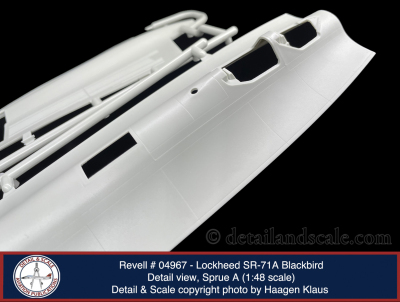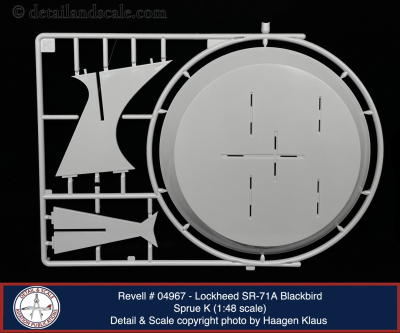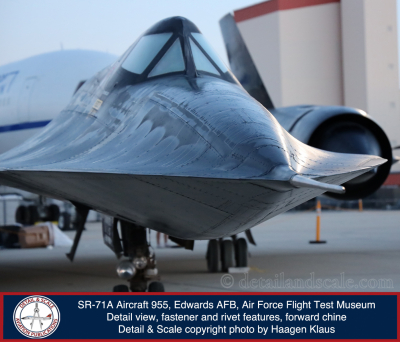Revell SR-71A Blackbird — 1:48 Scale


Perhaps the most remarkable aircraft in this history of aviation (that we know about so far) was the Lockheed SR-71 Blackbird. This Cold War spy plane provided on-demand intelligence for the United States over nearly four decades. Beyond its exotic appearance, it was the fastest and highest-flying operational aircraft in history. In 1984, Testors released a 1:48 scale SR-71, and it was a classic. However, the old Testors kit is quite obsolete by today’s standards. Building an accurate and well-detailed Blackbird from the Testors SR-71 requires a lot of additional work. In 2022, Revell released a new tool 1:48 scale Blackbird. Let’s check it out.

Even before the infamous shootdown of a U-2 flown by Francis Gary Powers on May 1, 1960, it was clear that the clock was ticking: the ability of American spy planes to surveil the USSR with impunity would not last forever. The solution was to create a reconnaissance aircraft that would fly above Soviet Air defenses, and that would be so fast that nothing could intercept it. The CIA approached Kelly Johnson and the Lockheed Skunk Works in 1957 to build such an airplane which was first known as Project Archangel and became the A-12. It was a deep black project, and aspects of these aircraft remain classified to this day. Besides operating at extreme speeds and altitudes, the A-12 also was the first to employ stealth technologies to reduce its radar cross-section. The Skunk Works also had to find engineering solutions to the truly daunting challenges of high-speed flight. These included airframe structures, fuel, and lubricants that would withstand the extreme thermal environment, to air inlets capable of functioning at Mach 3-plus. A contract was issued in February 1960 for twelve A-12 aircraft. The first CIA A-12 flew from Area 51 at Groom Lake, Nevada, on April 25, 1962. The single-seat A-12 had a successful career that lasted into 1968. The A-12 gave rise to the YF-12 interceptor and the M-21 drone carrier, but these never reached operational status. Its other descendant – the two-seat SR-71 which was built for the USAF – achieved legendary status.
The first SR-71 took to the skies at Palmdale Plant 42 on December 22, 1964. By 1966, the SR-71 was operational with the Air Force. The aircraft routinely cruised at Mach 3.2 and 85,000 feet, but according to some, an SR-71 could flirt with yet higher airspeeds and altitudes under certain conditions. The enigmatic Blackbirds flew more than three thousand missions over North Vietnam, North Korea, Lebanon, Libya, and other points of interest. Since direct overflights of the Soviet Union were politically impossible since 1960, Blackbirds flew just outside of Soviet airspace and used their remarkable altitude to peer deep inside the Iron Curtain. Reportedly, hundreds of SAMs were shot at Blackbirds and many intercepts were attempted, and all failed. Over the years, the SR-71 carried a wide range of powerful cameras and specialized sensors including side looking airborne radars and signals intelligence gear. A total of 29 SR-71As, two SR-71Bs, and one SR-71C had been manufactured when the production run ended in 1968. Secretary of Defense McNamara ordered all the tooling destroyed at that time.
The SR-71 was retired in 1990 following intense and politically complicated debate, partially driven by the notion that advances in reconnaissance satellites and follow-on spy planes made the Blackbird obsolete. Yet, the lack of a replacement and the limitations of space-based platforms saw the reactivation of a small detachment of SR-71s in 1995. By 1998, the Air Force retired the Blackbird for a second and final time, and the last Blackbird flight was made by NASA Dryden’s SR-71B in 1999.

Revell’s 1:48 scale SR-71 Blackbird kit contains 200 light gray injection molded parts on fourteen sprues and six clear parts on two clear sprues. The full-color instruction booklet guides the build over 68 steps. The decals provide markings for four airplanes:
- SR-71A, 61-7958, world speed record flights, 27-28 July 1976
- SR-71A, 61-7955, Lockheed Flight Test Aircraft, Palmdale Plant 42/Edwards AFB, 1972-1984
- SR-71A, 61-7972, New York to London and Los Angeles to Washington, D.C. record breaking flights, 6 March 1990
- SR-71A, 61-7967, USAF Last Flight – Det 2, Edwards AFB, 10 October 1997
Strengths: Scale aircraft modelers have awaited a new-tool SR-71 for decades. The 1:48 scale Testors kit was a revelation to many scale modelers in 1984, and it is one of my personal sentimental favorites. Yet, as time went on, it became clear that the Testors kit lacked a good deal of accurate detail, and it was plagued by some very difficult fits. It took 38 years for a new-tool 1:48 scale Blackbird kit to emerge on the market via Revell of Germany.
When built, this will be a big model, and it comes in an impressive top-opening box that is sturdier than the standard Revell kit boxes. First impressions followed up by careful study of the kit parts agree: Revell has done a very good job in capturing the SR-71. In practically every way, it surpasses the classic Testors kit. One of the ways in which the Revell kit excels is their approach to Blackbird construction is simpler. Overall parts breakdown and construction is streamlined. The upper and lower fuselages are two pieces, and the unpleasant forward chine-to midchine- to upper mid fuselage one may recall from the Testors kit is absent. Also, the nacelles are each three-piece items that are engineered to fit together with ease. My test fitting of parts and accounts from people who have built the kit indicates overall fit is very good, and seamwork is minimal. The kit features recessed panel lines and otherwise very good surface details including the leading and trailing edge RAM panels (but see below). The corrugated surfaces of the upper and lower fuselages are not at all overdone. A massive longeron runs the width of the interior of the fuselage, and a few other strategically located spars all help to provide solid internal structural stability of the model.
From fore to aft, let us start with the nose. The pitot boom looks good but has a little flash that needs to be removed. The nose section of the SR-71 was modular and would contain various reconnaissance systems packages. The kit provides optional parts for either the nose with the earlier CAPRE side looking radar or the later-life ASAR high-resolution synthetic aperture radar. Both nose versions have great-looking Radar Homing and Warning (RHAW) antennas on the leading edges of the chine.
The cockpits for the pilot and RSO (Reconnaissance Systems Operator) are a mixed bag. Revell executed rather nicely detailed instrument panels and side consoles with lots of raised detail. Detail painters will enjoy what the kit provides here, but cockpit details are overall a little simplified and there are no instrument dial face details. The ejection seats are rather underwhelming (see below) and side consoles also appear a little simplified. The pilot’s throttle quadrant is present, but the throttles themselves look to be more like 1:72 scale in size. If detail painting is not one’s preference, very nice alternate decals are provided for the instrument panels and side consoles. Even though they are two-dimensional, the decals provide greater visual detail than the plastic parts alone. That said, I would recommend for anyone using the decals to sand the instrument panels and side consoles flat. Aligning the decals to all those raised cockpit features will be a very challenging proposition, and any misalignment with any raised details underneath the decals would result in a sloppy looking final product.
Landing gear and gear wells are basic, but generally accurate for what is provided. The nose gear has a nicely represented landing light and nosewheel hydraulic steering actuator, and the main gear and wheels also feature a comparably good level of detail. The nose gear well has a limited level of detail but does include the nose gear door actuators and other basic features. Main gear wells are limited but include the very prominent tire cans and the large drag links that extended and retracted the main gear. The nose and main gear tires are okay, but a scale modeler interested in accuracy will wish to purchase either the ResKit or Hypersonic Models wheel set, which are more accurate in terms of tire shape and includes nose tire tread details (absent in the kit parts).
The in-flight refueling door can be positioned as open or closed. When an SR-71 powered down, the in-flight refueling door always retracted into the sunken “open” position as soon as hydraulic pressure bled off. The engine inlets are decent, and the full inlets are represented here in this kit. The inlet spikes appear to be well done and correctly taper aft. The inlet “mice” are present, which were sixteen fixed canoe-shaped devices that ringed the inlet interior and smoothed out airflow. The inlet assemblies terminate with the J-58 engine first stage compressor blades. However, do note that a lot of this detail will be very hard or impossible to see in the completed model, along with any seams from the three-piece cylindrical inlet duct. The exhausts are generally accurate, and the depth of the afterburner cans appear correct. They are not significantly foreshortened or shallow, which is a chronic problem with practically every other Blackbird kit. The flame holders are molded integrally as part of the aft engine face. A detail-minded builder will again want to purchase the ResKit exhaust nozzles set, as they are far better than these plastic parts. Furthest aft, the four elevons are separate pieces, and their mounting tabs are designed for “straight-in” assembly. If the scale modeler hoped to have their elevons drooped as they would sometimes be while on the ground, these parts can be rather easily modified.
This issue of the kit comes with two “bonus” features. I understand that these two features are absent in the second, less expensive Revell SR-71 release aimed at the U. S. market (kit # 85-5720). First, it contains two complete models of the mighty J-58 engine, and they look quite good, even when compared to the J-58 that is on display at the Smithsonian’s Udvar-Hazy Center. Plenty of the smaller lines, wires, and tubes are not present, but what is there will take the detail-oriented modeler rather far. Second, there is a large display stand (a bit smaller in diameter than the average dinner plate) upon which the competed model and the two J-58 engines can be displayed.
The decals are printed by Cartograf and appear technically perfect. White colors appear properly thick and opaque. Carrier film is very thin. Extensive airframe stencils are also included for both the high-visibility and low-visibility Blackbird schemes. The choices in markings options are good in that they capture some historic SR-71s, and I like the fact that they include record breakers, the Blackbird at Udvar-Hazy, and Lockheed’s flight test jet. Yet, these choices might also be a bit conservative. Over the years, there have been many more interesting examples of Blackbird tail art, from “Ichi-Ban” to the “Nighthawk” and several NASA schemes. Decals from Caracal (and Afterburner, if you can ever find those long out-of-production sets) might help some builders to find the schemes that appeals to them most.
Weaknesses: To be certain, Revell’s new-tool 1:48 scale SR-71 by far and away superior to the old Testors kit. Still, many detail-oriented scale modelers will feel that it leaves various things to be desired. First, I would say the kit’s SR-1 ejection seats are not just basic but are rather inaccurate. They do not capture the hefty parachute pack and seat pad, while seat pad details, the seat launch rails, and other small items are missing. Inaccurate shoulder harnesses and lap belts are also molded directly onto the seat. Here, the cast resin SR-1 seats by Hypersonic Models or Eduard are highly recommended. Note that the RSO’s instrument panel features a Multi-function Display (MFD). This is only appropriate for a late-life (1995-1998) era Blackbird. Modeling earlier jets would need to sand that down and replace it with a cathode ray tube-type screen.
Any look at the real airplane in person or in reference books illustrates that when the canopies are up, there is a lot of equipment and other details on the insides of the canopies, along the canopy sills, and in the aft cockpit decking. All these items are missing in the kit.
The lack of camera windows in the underside of the forward nose and the underside Q-Bays is noted, though the Blackbirds in this kit were configured as CAPRE or ASAR aircraft. It is not a big issue to me, but if one were to backdate their SR-71 to an optical camera-carrying platform, the panel lines are there for the Q-Bay camera ports. One could simply hit them with a high gloss coat to simulate glass or go further and start cutting and work on a scratch built solution.
The exterior surfaces of the airframe are simplified. Again, even a casual look at the real airplane in person or in reference books reveals the presence of thousands of visually prominent fasteners and rivets on the skin of the airplane (particularly, the forward half of the SR-71 and the engine nacelles). The exact count of fastener and rivet details on this kit’s exterior is zero. Missing from the left forward chine is a prominent blade antenna. The top of each forward engine nacelle had a small pitot probe, which is also absent in the kit. Reference photos are included of these features in 1:1 scale in the review photoset below.
For the price of the kit, one may also find some disappointment in the landing gear bays. They are very spartan. Items such as the pair of very prominent spherical liquid nitrogen tanks in the ceiling of the nose gear well are represented as featureless semi-cylindrical shapes. The fore and aft walls of the main gear wells are veritable jungles of wiring and piping, but the kit parts are practically featureless. Injection molding can of course be better than this. I would recommend the aftermarket landing gear well sets from Metallic Details be used instead.
Engine service carts would have been a nice touch to display the J-58s upon in a more realistic fashion. One can hope that an enterprising aftermarket detail manufacture feels the same and produces an engine cart.
One appealing feature in the Testors kit but not here in the new Revell offering is the option to build an SR-71B (or C). The entire upper fuselage is a single piece, meaning that Revell would have to produce an entire second upper fuselage for a two-seat trainer Blackbird. Any potential future conversion set would require a decent amount of cutting to remove the rear cockpit and replace it with a cast resin or 3-D printed raised aft cockpit. It could be feasible to integrate the parts from the old Testors kit. Admittedly, I have only given this proposition a quick assessment but the idea of using donor Testors parts deserves deeper study. As a big fan of the unique looks of the Blackbird trainer version and of trainers in general, I am already pondering building my Revell kit as the -B model Blackbird.

Revell’s new-tool 1:48 scale SR-71 Blackbird takes a major step forward as being the best 1:48 scale Blackbird available. It does a good job in capturing the many fundamental elements of the SR-71’s overall design, complex shapes, and other features. It is thus significantly more accurate than the classic 1984 Testors kit and looks to be the basis for a great SR-71 model. Detail-oriented scale modelers will want to take it much further, with a range of potential improvements in detail and accuracy that emphasize the cockpit and ejection seats, canopy interiors, landing gear wells, and (potentially) the exhaust nozzles. There are now a diverse range of aftermarket detail sets for this Blackbird from Eduard, Hypersonic, ResKit, and Metallic Details, and others that can improve this kit. With the anticipated new-tool 1:48 scale SR-71 from Gaspatch and Hypersonic Models upcoming, we look forward to seeing how well the Revell kit will compare.
We sincerely thank Revell for the review sample. You can find them on the web at http://www.revell.com/germany.
Haagen Klaus
Scale Modeling News & Reviews Editor
Detail & Scale





































